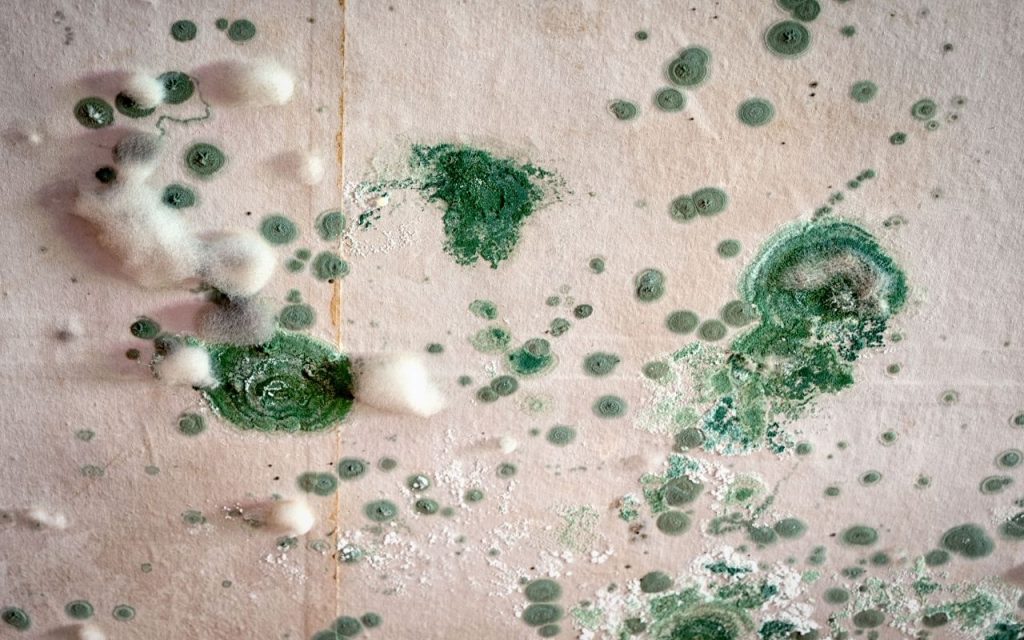Oftentimes, you’ll hear about this dynamic duo just about any time water damage is addressed. But what is the difference really? How often do we hear the term “mold and mildew” lumped together without any further explanation? Sure both often appear in tandem but there must be some distinction between the two, right?
Yes. Mold and mildew are two groups of fungi drawn to warm, moist spaces. And left unchecked they can lead to property destruction or even health issues. But there are some key differences between them including size, texture, and color. Keep reading to learn how this troublesome pair differs and how to identify them.
What is Mold?

Mold is a type of fungus containing multiple identical nuclei that combine into one single organism or colony. Put plainly, it’s a gross organism with a bad attitude. As it feeds and grows, most species will penetrate deep into the material it latched on to. Oftentimes, mold will appear in black or green patches. It can have a fuzzy or slimy texture to it. There are thousands of mold species that can be found in your home but most can be categorized into a handful of types.
Types of Common Household Molds
- Aspergillus is one of the most common types of mold found indoors. With over 185 species of aspergillus, this type of mold can present in a variety of colors: gray, brown, yellow, green, white, or black. It’s long flask-shaped spores make it possible for this type of mold to grow in thick swatches.
- Alternaria is the most common allergenic mold in the world. That means it can potentially cause irritation to humans exposed to it. Alternaria can grow on walls, in showers, under sinks – basically anywhere damp.
- Chaetomium is often found in water-damaged homes and buildings. Over time, it will likely change colors. It usually starts off white or grey and eventually shifts to brown to black. It has a cotton-like texture and a notably musty scent.
- Cladosporium is unique to many mold types as it can thrive in cold environments too. It has a black or olive-green color and spreads quickly on materials such as fabrics, upholsteries, and carpets.
- Penicillium is blue or green and has a suede-like texture. Similar to chaetomium, it also gives off a musty odor. Its spores spread rapidly and can often cause serious allergic reactions.
- Stachybotrys chartarum, more commonly known as black mold, is a toxigenic mold that can cause severe respiratory issues. As the name suggests it can appear black but can also be dark green. It will often have a slimy texture. Black mold feeds off cellulose material such as wood, paper, wicker, or cardboard.
So many types of mold can grow within a home or any indoor environment, and they pretty much look very similar to the human eye. However, know that all of them are problematic and can cause health risks. While mold is always present in the air, colonies of mold are the real enemy.
Read this article on how to prevent mold growth!
What is Mildew?

Mildew is actually a subset of the broader mold family. So yes, technically speaking, mold and mildew are the same. But mildew can be far easier to remove than other types of household mold. Unlike most mold, mildew grows in a flat layer without penetrating into the material. It’s primarily found growing on living plants but can be found in moist areas – even with limited air circulation.
Types of Common Household Mildew
- Oidium-Erysiphe, or powdery mildew, is a plant parasite known to cause significant damage to crops. You’re likely to encounter this type of mildew in your garden or on your houseplants. It will often start out as white or gray patterned splotches and can turn yellowish-brown or black.
- Peronosporaceae, or downy mildew, affects agricultural products but can also appear on other organic surfaces too. It starts off as yellow spots and slowly darkens to brown.
How to Avoid Mold and Mildew
Mold and mildew love moisture. Pay close attention to areas that collect condensation. This is where they will likely try to take root. It’s also vital to keep up with regular cleaning. Mold spreads quickly. Be sure you’re regularly disinfecting areas where mold thrives such as the bathroom, kitchen, or any other warm, wet spaces. Check around your water heater.
Here are some additional tips:
- Use exhaust fans that vent moist air out of your home after showering or cooking.
- Keep humidity levels low.
- Dry standing water immediately.
- Before your next renovation project, add inhibitors to any paint you use.
- Fix leaks within 24 hours, get rid of water and moisture, sanitize the area once dry.
Already Dealing With an Infestation?
Since mold and mildew can grow as quickly as 24 – 48 hours after a leak or flood, oftentimes an infestation can break out before we even have the chance to gain our bearings. Luckily, there are mold remediation options to rid your home of invasive fungi.
If you’re in the Central Denver area and you’re dealing with a mold infestation, give Restoration 1 a call! Our certified restoration experts will track down every trace of mold in your home and eliminate the issue. With high service standards and 24/7 response time, Restoration 1 is always here when disaster strikes.








